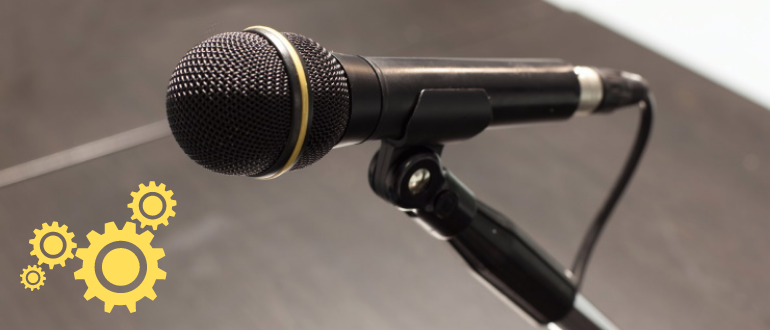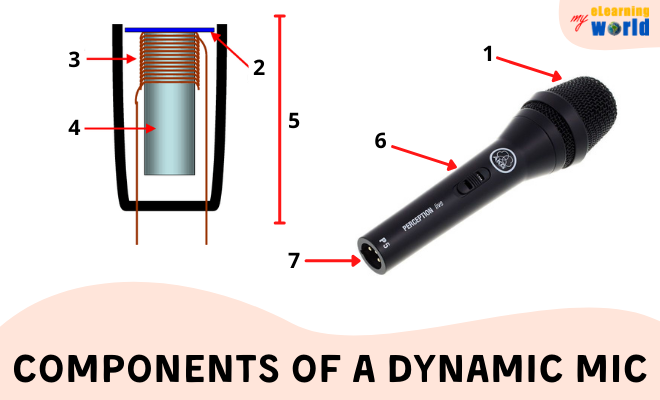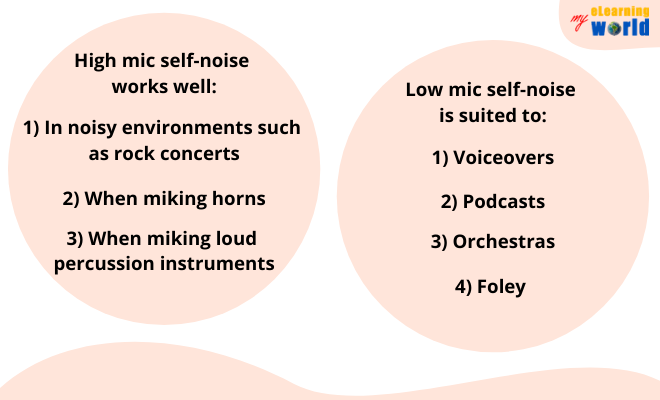What is a dynamic microphone? How do dynamic microphones work? And how does a dynamic mic compare to condenser microphones?
These are just some of the questions you might have when setting up your studio.
If you want a microphone that’s simple, multi-purpose, and rugged as a tank, then a dynamic microphone is a great choice.
Prized by singers, podcasters, and voiceover artists, the best dynamic microphones are also used to effectively mic up drums, electric guitars, and acoustic guitars.
However, the voiceover equipment market can be a confusing landscape that requires a proper guide, and a dynamic mic has many important attributes that you’ll need to understand before considering specific options.
So how does a dynamic microphone work? Read on to find out.
Main Types of Microphones: Dynamic vs Condenser Microphones
There are two types of mics, dynamic and condenser microphones.
1. Dynamic Mics
They have minimal moveable components and don’t need an internal amplifier, batteries or outside power source. This is because dynamic microphones actually produce power via their electronics.
Dynamic mics transform sounds into audio signals via the electromagnetic principle, also called the electromagnetic theory of induction. According to this principle, when metal passes through a magnetic field, an electrical current is transported into the metal.
This video provides a clear, simple demonstration of a dynamic mic’s components and how they work. Watch this and you’ll have a clearer answer to your question “What is a dynamic microphone?”
Because they transform one form of energy into another, dynamic microphones are called transducers.
2. Condenser Mics
Condenser microphones are extremely sensitive and are best used with acoustic guitars and quieter vocals. They’re also very well-suited to studios. Condenser mics precisely capture singing or instrumental nuances.
However, since condenser microphones are so sensitive, they’re susceptible to distortion and can pick up popping noises and breathing sounds.
Types of Dynamic Microphones
There are two types of dynamic microphoness to consider for your intended use. These are moving coil and moving ribbon dynamic mics.
1. Moving Coil
Moving coil dynamic microphones are the most commonly used type. They utilize a coil of wire attached to a diaphragm within a magnetic field. When sound, such as a voice, vibrates the diaphragm, it makes the coil vibrate, which creates an electrical signal.
2. Moving Ribbon
Moving ribbon dynamic microphones are extremely sensitive mics.
Ribbon microphones are designed to be used for atmospheric types of sounds, such as jazz, folk, blues, or more restrained vocals.
Ribbon microphones contain a thin ribbon of aluminum foil situated between two magnets. When sound waves vibrate the ribbon, they generate an audio signal.
Components of Dynamic Microphones
Dynamic mics have components that are uniquely theirs.
Dynamic microphones have seven parts that, together, create their one-of-a-kind sound.
- Windscreen (or Grille). The windscreen is the part of the microphone that you speak or sing into.
- Diaphragm. The diaphragm collects sounds and transforms them into electrical currents. It can be equated to the human eardrum.
- Coil. The coil is a small section of wire attached to the diaphragm. When the diaphragm moves, it shifts the coil, which creates an electrical signal.
- Magnetic Core. It produces a magnetic field for the coil.
- Capsule. In the capsule, sound vibrations are converted to electrical signals, which are sent to the speakers.
- Body. The body is the external housing of the device. The sturdier the body, the more easily its electronics will be able to handle inevitable falls, knocks and drops.
- Output. The output (or output jack) is where a cable is plugged into the microphone so that signals can be transported out as sounds.
Here’s how all of these components come together to make a dynamic mic work.
How Does a Dynamic Microphone Work?
A dynamic device only has a few parts, but those parts add up to a world-renowned mic!
Windscreen
The windscreen is located underneath the portion of the device that looks like a metal grille. It’s a foam lining designed to protect the mic’s diaphragm from wind interference. Additionally, it prevents dust and debris from entering the microphone.
Windscreens are designed to cut down on disruptive plosives, as well. Plosives happen when a mic is overloaded with blasts of air from words containing the consonants “b,” “p,” “d,” “t,” “g” and “k.” Plosives cause intrusive popping or hissing sounds.
If a microphone’s windscreen can’t effectively eliminate plosives, it can be aided by a pop filter. Pop filters (also called pop shields or pop screens) are in-studio devices that dispel these annoying sounds before they reach the mic.
Windscreens are essential for outdoor scenarios. They’re also valuable in the studio.
Diaphragm
The diaphragm is a two-sided membrane of Mylar (biaxially-oriented polyethylene terephthalate) that moves when sound enters the device. At a diminutive five microns, its delicateness makes it exceptionally attuned to vibrations in the surrounding air.
The diaphragm is usually the make-or-break component of a microphone’s sound quality.
Coil
Copper is used for several reasons:
- It produces a powerful audio signal.
- It optimizes electromagnetic induction.
- Its light weight makes the coil-diaphragm duo more receptive than weightier substances.
When the diaphragm vibrates in response to fluctuating air pressure, it moves the coil. The coil vibrates back and forth in a magnetic field, transforming sound into an electrical signal, which is then carried to the speakers.
Magnetic Core
The magnetic core produces a magnetic field for the coil so that the vibrations create an electrical signal.
Capsule
The diaphragm is vital to making the capsule act as a transducer. A transducer, also called an element, transforms sound waves (acoustic energy) into audio signals (electrical energy). The capsule is integral to a microphone’s sound.
Output
The output, or jack, is the area of the device where you plug in a cable. Most microphone outputs will accommodate an XLR cable, a three-pronged cord that transports stereo signals.
Some lower-end mics have an attached cable.
There is a difference between the way different types of mics work. You can read about wireless microphones’ features in this article.
Dynamic microphones have essential features that make them integral parts of performances, presentations, and studios.
Features of the Dynamic Microphone
Dynamic microphones have eight features that factor into their sound.
1. Frequency Response
Frequency response, simply put, refers to a mic’s response to various frequencies. It’s the range of frequencies that the microphone can distinguish and replicate. Frequency is a vibration’s speed and is gauged in hertz (Hz).
Let’s say a frequency is vibrating at 50 times per second. This equates to a frequency of 50 Hz. Sound waves always vibrate at precise frequencies, and all models have a unique sound characterized by their receptiveness to certain frequencies.
For example, some models are sensitive to lower frequencies (referred to as a “darker” sound) while “brighter”-sounding microphones are more attuned to higher frequencies.
2. Proximity Effect
The proximity effect is an increase in low bass frequencies the nearer a mic is moved to a sound’s source. In other words, the nearer you are to a microphone, the more low-frequencies it will capture.
Typically, the proximity effect happens when the device and its sound source are about one foot or less from each other. This effect helps ordinary podcasters, for example, sound as though they’re channeling Barry White.
Conversely, when you move away from a mic, it picks up fewer low frequencies, producing an echo effect.
3. On-Axis Response and Off-Axis Response
Axis refers to the angle at which a sound enters a microphone. There are two types:
- On-Axis Response
On-axis response describes sound that enters the mic head-on. This angle has a bright sound, and if your device has a lower sensitivity to high frequencies, on-axis could impart more definition to the sound.
However, if it’s more sensitivity to highs, on-axis could make it more vulnerable to harshness or hissing. Plosives could be an issue, as well.
- Off-Axis Response
Off-axis response refers to any sound that isn’t directly in front of the microphone. For instance, if there is a sound coming from the side of the room, it will produce an off-axis response. The frequency of the audio will shift or distort.
Off-axis recording can intentionally be used to remedy the abrasiveness of high frequencies.
4. Polar Patterns
A polar pattern illustrates from which direction(s) a mic will be sensitive to picking up sound and from which direction(s) it will ignore sound. At lower frequencies, devices become less directional, and at higher frequencies they become more directional.
There are several categories of polar patterns:
Unidirectional/Cardioid Pattern

Because of this, you need to sing or speak into what’s called the “voice side.” Otherwise, the sound will be picked up badly or not at all.
Cardioid microphones are great for general use, and they regulate feedback. This type has the proximity effect.
Directional/Hypercardioid and Supercardioid Pattern

These microphones have the proximity effect.
Bidirectional/Figure 8

These microphones are also feedback-resistant and have the proximity effect.
Omnidirectional

Omnidirectional mics don’t have the proximity effect.
5. Transient Response
Transients are some of the trickiest aspects of attaining a decent microphone sound. Transients are abrupt, drastic noise spikes. They can happen when a guitar string is first plucked, when a drum is first attacked or when a singer abruptly sings consonants such as “t.”
Transients are difficult to control or predict, because they can happen anytime, to any instrument. They’re also problematic because it’s sometimes difficult to regulate the amount of force used for singing or playing an instrument.
However, dynamic mics react more slowly than condenser ones and may have trouble keeping up with quick transients. In essence, the microphone is too slow.
However, this can actually be an advantage when recording certain types of instruments or vocals.
6. Sensitivity
Sensitivity refers to a mic’s aptitude for transforming acoustic pressure into electrical voltage. If two devices are subjected to the identical sound pressure level and one produces a higher voltage than the other, it has superior sensitivity.
Higher sensitivity microphones need less amplification to make their output sound useable when it reaches the mixer. Less sensitive models need more amplification.
However, this doesn’t necessarily mean that a mic with higher sensitivity is better than one without.
7. SPL (Sound Pressure Level)
Sound pressure level, or SPL, indicates the loudness a microphone can manage before it distorts. Dynamic mics are best at dealing with the loudest sounds before succumbing to distortion.
Max SPL, or maximum SPL, refers to this threshold. Some devices have controls that can make them more capable of withstanding louder instruments, such as electric guitars.
8. Noise
Self-noise, also called equivalent noise level, is the signal a microphone itself generates when there is no sound source. All devices have self-noise. Often, it manifests as a tiny hiss or sounds like white noise.
A current running through the circuitry of an active mic (technically known as Poisson noise or shot noise) is mainly responsible for self-noise. Another culprit is thermal noise (technically called Johnson-Nyquist noise), which means that as temperature escalates, so does self-noise.
Noise can also be created by random air molecules pelting the diaphragm, as well as preamp gain and mic cable disturbance. This is technically known as Brownian movement.
However, self-noise isn’t all-bad. In fact, it can be useful in certain situations. In a noisy setting, a microphone’s self-noise helps it reject quieter sounds, leaving more space for loud ones.
Advantages and Disadvantages of Dynamic Microphones
Like any piece of equipment, dynamic mics have their pros and cons.
A dynamic mic’s advantages outweigh its disadvantages.
Advantages of Dynamic Microphones:
- They work well in applications that call for a warm sound, such as voiceovers.
- They need no power source. This makes them extremely easy to use in a variety of situations.
- They can endure loud volumes.
- They’re rugged and can be very forgiving of all sorts of abuse.
- They’re versatile and can be used for numerous applications.
- They’re water-resistant.
- They capably handle plosives.
- Since they’re simple, they can be very affordable.
Disadvantages of Dynamic Microphones:
- They’re not ideal for recording delicate sounds.
- They capture a limited amount of high-frequency detail.
- They can’t handle recording harmonics.
- Less detailed sound.
- You’ll need to be close to the diaphragm to receive a clear signal.
- Dynamic microphones are versatile pieces of equipment that have a variety of applications.
What Are Dynamic Mics Mostly Used For?
Dynamic microphones are suited to a wide range of uses:
- Podcasts
- Voiceovers
- Singing (particularly with several people)
- Broadcasting
- Studio recording
- Presentations
- Concerts
- Webinars
- Videos
- Recording drums and amps
- Situations that call for a mic that’s water-resistant and impact-resistant.
Useful Resources
A Final Word on Dynamic Microphones
In addition to all of these uses, dynamic microphones are ideal for creating professional YouTube videos. The right dynamic YouTube mic can elevate your videos to a more polished level. With a sturdy design, a sound that will make your voice sound warm and inviting and adept handling of pesky plosives, they’re a great choice for your next YouTube videos.
Hopefully, the information in this article has answered your questions, “What is a Dynamic Microphone?” and “How Does a Dynamic Microphone Work?”


















